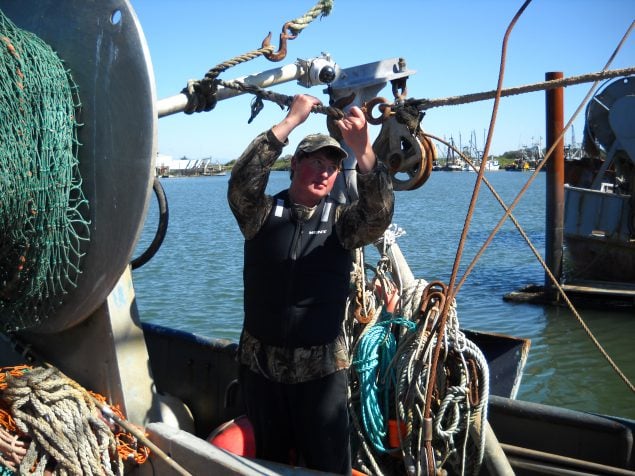PFD Manufacturer Adopts NIOSH Research into Product Development Process
November 2014
DHHS (NIOSH) Publication Number 2015-119
A Story of Impact:

Personal floatation devices (PFDs) save lives in the fishing industry1-3. Most work-related fatalities in the fishing industry are caused by drowning after a vessel disaster or a fall overboard4. Although the risk of drowning is high, most deckhands do not wear PFDs while working on the deck. There are currently no mandates by regulatory agencies for these workers to wear PFDs.
Past research conducted by NIOSH examined the predictors of PFD use in the fishing industry in Alaska5. Workers who believed that PFDs are an entanglement hazard had low PFD use, as did workers who believed that PFDs interfere with work. Workers may wear PFDs more often if they are familiar with newer models that have features which alleviate their concerns regarding comfort6.
The NIOSH Alaska Pacific Office conducted a study to determine which type of commercially available PFD resulted in the highest satisfaction in actual fishing industry working conditions6. Different vessels have unique on-deck work processes, thus four vessel types were targeted: crabbers (vessels dropping baited pots to catch crab on the ocean floor), longliners (vessels anchoring strings of baited hooks on the ocean floor to catch a variety of bottom fish), gillnetters (vessels towing gillnets to catch primarily salmon), and trawlers (vessels towing large trawl nets to catch groundfish and pelagic fish). Six PFD models were selected to provide a variety of features to test for comfort and functionality. The study revealed that workers on different types of fishing vessels had varying preferences for PFDs. Because no regulations mandating the use of PFDs exist, manufacturers may have more success in supplying PFDs if they engage workers in the design and promotion of newer, more comfortable PFDs.
Based on the results of the NIOSH PFD study, a national PFD manufacturer realized there was a need for innovative PFD designs to improve comfort for workers in the fishing industry. They extended the NIOSH study and took a variety of commercially available PFDs to test on several boats where crewmembers gave feedback on the mobility of each PFD. Based on their market research, the company developed a prototype designed to be worn under bibs and raingear with 12 lbs. of flotation, the optimal amount to maintain a low profile while still maintaining buoyancy. This new vest could be worn continuously, even when going ashore, but would still allow buoyancy in case of a fall overboard. This prototype was field-tested for continuous wear and a number of adjustments were made based on fishermen’s feedback, including shortening the overall height of the vest and adding indentations on the sides for flexibility when sitting and stepping up, increasing the diameter of the armholes to increase range of motion, lowering the neck to aid in looking downward, and adding reflective loops where gear could be secured to replace pockets that would catch on equipment. Their final product is now commercially available.
In the commercial fishing industry 86% of fatalities are caused by drowning4. In an effort to increase personal flotation device (PFD) use and reduce these fatalities among workers, NIOSH conducted a study to determine which types of commercially available PFDs resulted in the highest satisfaction in real working conditions6. Results of this study were used by a PFD manufacturer to design and manufacture an innovative ‘tactical deck vest’ that could be worn continuously on deck while also providing flotation. The vest is now commercially available.
View/Download Entire Document: PFD Manufacturer Adopts NIOSH Research into Product Development Process [PDF – 1,139 KB]
![]()
![]()

![]()
Visit www.cdc.gov/niosh/topics/fishing for more information about commercial fishing safety in Alaska. The study, Worker satisfaction with personal flotation devices (PFDs) in the fishing industry: Evaluations in actual use, was authored by Devin L. Lucas, Jennifer M. Lincoln, P. Somervell, Theodore D. Teske and was published in Applied Ergonomics 43 (2012) 747-752. The data from this study is available to other interested groups; please contact the NIOSH Alaska Pacific Office for more information. You can also follow the NIOSH commercial fishing safety program on Twitter: @NIOSHFishing.
References
1 Jones, C.S., 1999. Drowning among personal watercraft passengers: the ability of personal flotation devices to preserve life on Arkansas waterways, 1994-1997. J. Ark. Med. Soc. 96, 97-98.
2 National Institute for Occupational Safety and Health, 1993. Preventing Drownings of Commercial Fishermen. U.S. Department of Health and Human Services, Centers for Disease Control and Prevention, National Institute for Occupational Safety and, Health, DHHS (NIOSH), Cincinnati, OH. Publication no. 94-107.
3 National Transportation Safety Board, 1993. Safety Study: Recreational Boating Safety. National Transportation Safety Board, Washington, DC.
4 J.M. Lincoln, D.L. Lucas (2010) Occupational Fatalities in the United States Commercial Fishing Industry, 2000-2009, Journal of Agromedicine, 15:4, 343-350
5 D.L. Lucas, J.M. Lincoln, S. E. Carozza, et al. Predictors of personal flotation device (PFD) use among workers in the Alaska commercial fishing industry. Safety Science 53 (2013) 177–185.
6 D. L. Lucas, J.M. Lincoln, P. Somervell, T. Teske. Worker satisfaction with personal flotation devices (PFDs) in the fishing industry: Evaluations in actual use. Applied Ergonomics 43 (2012) 747-752.
The use of trade names and commercial sources is for identification purposes only and does not imply endorsement by the National Institute for Occupational Safety and Health (NIOSH), the Centers for Disease Control and Prevention (CDC), or the U.S. Department of Health and Human Services (HHS) or imply that one product is preferred by NIOSH, CDC, or HHS over other products manufactured by other companies.
SAFER • HEALTHIER • PEOPLE™
